Richard R. Schrock
Biographical
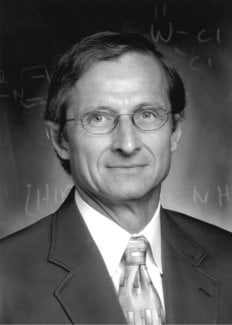
I was born in Berne, a northeast Indiana farming community proud of its Swiss heritage. Life was not easy for my parents, Noah J. Schrock, the second of six children, and Martha A. Habegger, the second of ten children. They married in 1933 during the Depression. My oldest brother, Luther, was born in 1934, Theodore in 1939. A few months after I appeared in 1945, the family moved to Decatur, about 13 miles north of Berne, where we lived until the summer after my fifth birthday. My most lasting memory of our first home is its proximity to the city swimming pool where I spent many happy summer days.
We moved into an old house on the west side of South 13th Street in 1950. The house required a good deal of work, but my father, who had been a carpenter for fifteen years, accomplished the renovation over a period of several years. The house was located on what seemed to me to be an enormous plot of land (one acre); the backyard took forever to mow on a steamy summer day and the vegetable garden produced quantities of corn, strawberries, melons, tomatoes, and raspberries. A large vacant lot extended south toward a small railroad that dove beneath the highway on its way east to a mill where tiles were made from the clay dug on the west side of the road. The process of mining the clay created ponds, which I explored along with the surrounding woods at length. In the summer I would fish, catch snakes and frogs, and build simple huts in the woods, which probably were the first indications of my love for designing and building, and for the outdoors. In the winter I learned how to ice skate and often (so it seemed) would come close to actually freezing toes and fingers. We never had much money, but the house was comfortable (except during the first, and especially cold, winter) and the food (fresh in the summer, canned in the winter) was plentiful for the five of us.
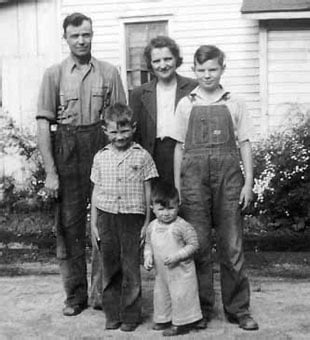
My father built a woodworking shop in the two car garage at the rear of the house where I also spent much time discovering, among other things, that it is not easy to drive nails into maple. I was not allowed to operate power tools at a young age, but my father introduced me to several as I became older, except his prize 1941 Delta table saw, which I eventually inherited when he died of leukemia in 1980 at age 69. He was a patient teacher even though I did not fully appreciate the difference between a chisel and a screwdriver or clear pine and a prized piece of birds eye maple when I was young. I learned many things by trial and error but nevertheless grew to appreciate what one can do with wood and the right tools used the right way. I maintain that interest to this day. Like most young Hoosier men at that time, I played on the school basketball, baseball, and football teams. Although I did not continue to play organized sports beyond age ten or eleven, sports provided me with a respect and need for physical exercise that I still have.
My curiosity and love of building things played into the hand of my older brother Theodore who presented me with the proverbial chemistry set on my eighth birthday. He was thirteen at the time and beginning to appreciate the beauties of science. His interest in chemistry continued through his college years but he eventually studied medicine instead and became a highly successful surgeon. I was hooked. I created a small laboratory at the end of a storage area for canned goods and used my budding woodworking skills to build shelves for the ever expanding collection of test tubes, beakers, and flasks. I obtained most of my equipment through a mail order supply house with money earned from an early morning paper route. I carried out simple experiments (combining acids and bases to make salts, making pleasant smelling esters, etc.) following the directions in chemistry laboratory texts handed down to me. When I reached the age of thirteen, Harry Dailey, the high school chemistry teacher, stoked my interest in chemistry with more textbooks and discarded equipment. I thought all equipment wonderful to behold. As I became aware of the power of burning natural gas, the lowly alcohol burner was replaced by the common Bunsen burner, and the Bunsen burner ultimately by a high tech broad-headed model capable of putting out a good deal of heat, enough to melt metals in a porcelain crucible and even sodium chloride.
After we moved to a house on Jackson Street in 1958, my laboratory grew in size, diversity, and complexity. I now had at my disposal relatively sophisticated and, if misused, dangerous substances in a small room in the basement. I was often interested in testing recipes for mixtures of oxidizing agents and oxidizeable materials as well as nitrating common household substances. Thankfully, there were no serious mishaps, although my mother tells stories that belie that statement, including one in which the local fire department was called to our home; fortunately only a small rug was burning, not the house. At least I also was quick to think and act.
My father went to San Diego, California, in the fall of 1958 to work in the construction industry with his brother, Clarence, and to explore the feasibility of moving west. In 1959 my mother and I joined him. She drove and I navigated cross country with my laboratory carefully packed in the trunk of the car. By the time I finished Mission Bay High School in 1963, both my parents had also fulfilled their dreams of finishing high school, something they had not been allowed to do in their youth. My interest in chemistry expanded in San Diego. I found a laboratory supply house where I could buy classic equipment (a 250 mL retort was coveted and purchased) and a drugstore where I could buy basic chemicals with some adult help of course. I discovered many wonderful things such as how to make bromine from KBr and sulfuric acid, how to make sodium (and chlorine) by electrolizing molten sodium chloride, and how to analyze for metals by making sulfides with brilliant and characteristic colors. I took up surfing and skin diving, and continued my interest in woodworking by designing, making, and selling fins for surfboards. I entered a regional science fair with a project that concerned osmotic processes in sea urchin eggs and managed to win a prize for it. I collected the sea urchins at low tide and harvested the eggs myself. That, and dissection of a sheep’s brain (which I greatly enjoyed) in physiological psychology later in college, was the closest I would come to following my brother into medicine.
I always assumed I would attend college and study chemistry. The only financially viable option was the University of California. I was accepted at Berkeley but chose to attend Riverside, a relatively new campus about 90 miles north of San Diego, because I thought that a smaller school might allow me to do more independent research earlier in my career. That proved to be the case. After the first exam in my first chemistry course at UCR, I was approached by Professor James Pitts who asked if I wanted a summer job. I agreed and began research in what broadly could be called atmospheric chemistry, a hot topic in the smog ridden Los Angeles basin and surrounding area at that time. In actuality, I spent my time learning to blow glass and construct vacuum lines, and to measure low concentrations of photolysis products using a temperamental, delicate, almost impossible to align, multi-pass Perkin-Elmer IR machine connected to a vacuum line. (Fourier Transform machines were not yet known.) A paper entitled “The Detection of Ethylketen and enol-Crotonaldehyde in the Vapour-phase Photolysis of trans-Crotonaldehyde” reported some of my work in 1968 after I had moved on to graduate school. I also worked “up the hill” with Dr. E.A. (Ed) Schuck and in 1966 found my name on a paper entitled “Rate Constant Ratios During Nitrogen Dioxide Photolysis.” I learned many things, scientific and otherwise, that need not be detailed here. One that I might mention was the joy (and sometimes discomfort) of hiking in the Sierra Nevada Mountains. I still enjoy mountain hiking, although the frequency has decreased considerably. I capitalized on my knowledge of IR spectroscopy during a summer of research at Dow in Midland, Michigan, where my oldest brother Luther was an engineer.
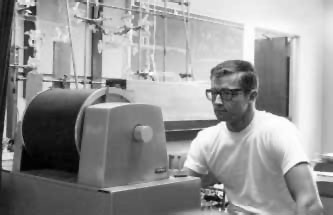
At Riverside I was influenced by a talented and enthusiastic teacher in physical chemistry named Jerry Bell. Jerry decided that I had enough ability to attend Harvard University for graduate study where he had received his Ph.D. I liked the idea, applied, and was accepted. I celebrated by listening to Rachmaninoff’s second piano concerto played by Byron Janis, loudly, through a Fischer amplifier and large home built speakers, each with a volume approaching 12 cubic feet; an arts in western civilization course at UCR had boosted my interest in music that I had acquired in high school. During the last semester at UCR I took an inorganic chemistry course taught by Fred Hawthorne who appropriately spent a good deal of time discussing boron compounds. Although I enjoyed organic chemistry, the possibility of exploring the chemistry of all elements in the periodic table was fascinating to me. Yet for some reason I still regarded myself as a physical chemist.
When I arrived at Harvard, I was scheduled to live in Perkins Hall, a graduate student dormitory. I was offered several possible roommates, among them David Swickard, a childhood friend from Decatur, who unknown to me was beginning graduate school in political science. Needless to say, he was surprised to find me in the dorm room when he arrived. I lived in Perkins for the first year and then moved to an apartment with several other friends near Central Square in Cambridge. The apartment was adequately furnished, convenient to Harvard, and cheap. I spent most of my time in the lab anyway. I was one of the constant residents in the apartment for the next three years, although from time to time I was uncertain how many roommates I actually had.
I had not visited Harvard or researched the faculty before arriving and had no plan concerning the kind of physical chemistry I wanted to pursue. My desire to permute compositions of matter did not seem to fit with the physical chemistry being done at Harvard at that time. Perhaps I had the wrong impression of what I wanted to do or what “physical chemistry” was. Therefore picking a research supervisor proved problematic. One day while walking dejectedly down the main hall of Mallinckrodt Laboratory I passed a long office/lab (in fashion in years past) where a recently arrived assistant professor sat at the desk. I entered and talked with John Osborn, who told me about transition metal chemistry, about the excitement of creating new, colorful, crystalline compounds, and about catalysis by transition metal species such as the rhodium catalysts he had developed as part of his doctoral study with Geoffrey Wilkinson at Imperial College. That sounded like what I wanted to do, make new compounds with potential uses, so I signed on. I am not sure John was totally pleased that I chose to work on rhodium since he may have felt that it was too close to his own doctoral work, although in the end the cationic complexes that I discovered turned out to be quite useful for asymmetric hydrogenation, at least those that contained the appropriate enantiomerically pure phosphine ligand. I also met Ryoji Noyori who was exploring catalysis by transition metal species in E.J. Corey’s group, and Mike Strem, who had started Strem Chemicals and for whom I made a sample of deuterated Zeise’s salt for the fantastic wage of $100, half a month’s pay at that time.
The late sixties were wild in Cambridge as in other university areas, with the Vietnam war escalating, and rebellions seething, or actually erupting. I decided I needed a break and had to see the world. I informed John that I would be traveling abroad for fifteen weeks during the summer of 1968 on a grand European tour. The mantra was $5 a day. I think I almost achieved that goal. Hitchhiking was still acceptable and helped the budget greatly, as did youth hostels and a diet of bread and cheese. I could not believe I actually was in Europe, visiting all the famous museums and practicing my high school Spanish and college German. My success with French was more modest. While I am eager to learn other languages, I do not have the special talent required to achieve that goal without actually having lived abroad.
In November of 1969, the 16th I believe, I meandered to a party near Davis Square where I met a tall blond school teacher named Nancy Carlson. She not only was beautiful but also bright and seemed attracted to me, which I found refreshing. We saw each other regularly that year and most of the next, and married in August of 1971, shortly after I finished and defended my Ph.D. thesis and she completed a master’s degree in library science. Only one job was available in 1971, for which there were several hundred applicants, so I considered myself fortunate to obtain a postdoctoral fellowship from the National Science Foundation to work at Cambridge University in the laboratory of Jack Lewis, later Lord Lewis. The year in England was the beginning of a long relationship with England that continues today. Our present house is graced by a brass rubbing of Roger de Trumpington (gold and silver wax on black paper), one of the oldest brasses in England. It took some time to rub a brass that size, and the church in the village of Trumpington south of Cambridge around Christmas time was unrelentingly cold. I discovered a great deal about the relative heat capacity of my body versus a stone floor. We rubbed other brasses, but that particular event remains in my memory because of the cold and the boy’s choir practicing their Christmas program in the background. I returned to the U.S. in the winter to look for permanent employment. Job offerings were still relatively meager, although I garnered a couple of offers. Upon returning to Cambridge I met Earl Muetterties, an associate director at the DuPont Experimental Station in Wilmington, Delaware, who was on a sabbatical at Cambridge, which was unusual for a nonacademic. He interviewed me and ultimately gave me an offer to work at the Central Research Department, which I accepted. At that time CRD was an academic department in an industrial setting; nothing close to it exists today. Nancy and I moved to Wilmington in August of 1972 with two bicycles purchased in England. I still have mine and ride it occasionally.
At DuPont I shared a lab with the remarkable Fred Tebbe, who was studying, among other things, reactions of ethyl aluminum reagents with titanocene dichloride. His most important and surprising discovery was what has become known as Tebbe’s reagent, a species made through the reaction of titanocene dichloride with trimethylaluminum. The most remarkable feature of Tebbe’s reagent is a methylene group bridging between titanium and aluminum, which could replace the oxygen in a carbonyl group in a Wittig-like reaction. I dabbled in cyclooctatetraene chemistry and synthesized compounds such as the anion of triscyclooctatetraene niobium, and blue Ta(C8H8)Me3, prepared through addition of the dianion of cyclooctatetraene to tantalum trimethyldichloride, the only known alkyl of tantalum, which had been reported by G. L. Juvinall in 1964. I found TaMe3Cl2 to be easy to prepare on a large scale from TaCl5 and dimethylzinc, which at that time could be purchased neat in large quantities. I became interested in the possibility of preparing other tantalum alkyl complexes. I was heavily influenced by G. Wilkinson’s synthesis of hexamethyltungsten. Wilkinson was a consultant for DuPont at the time. On a trip to DuPont in the spring of 1973 he told us about the synthesis and properties of that remarkable compound. I subsequently concentrated on the synthesis of tantalum pentaalkyl complexes and soon had made highly volatile and highly unstable pentamethyltantalum by treating TaMe3Cl2 with methyllithium. By July the attempted synthesis of pentaneopentyltantalum led to trineopentylneopentylidenetantalum, Ta[CHC(CH3)3] [CH2C(CH3)3]3 instead. That compound marked the beginning of high oxidation state carbene, or alkylidene chemistry, as stated in a book by Bill Nugent and Jim Mayer (Metal-Ligand Multiple Bonds, 1988) in which the actual DuPont notebook page which describes that discovery was reproduced. (Fortunately, that particular page also was an example of how to keep a proper notebook.) Shortly thereafter I prepared the first isolable terminal methylene complex, the structure of which was solved by Lloyd Guggenberger. George Parshall, my group leader, allowed me to do what I thought interesting and to work after normal hours, which greatly increased my productivity. In the fall of 1972 I first heard the term “olefin metathesis” from Earl Muetterties, who remained interested in the subject after he moved to Cornell in the summer of 1973. I started to follow the metathesis literature and began to suspect that the new alkylidene complexes that I discovered in 1973 might be relevant to that process, even though tantalum was not a known catalyst for olefin metathesis.
I was impressed by the high oxidation state chemistry of osmium imido complexes being carried out by K. Barry Sharpless at MIT and invited him to DuPont to give a talk, probably in late 1974. He was excited about the potential of the new alkylidene compounds I had discovered. He and several others at MIT pushed for an offer from MIT, which came in the spring of 1975. I accepted, even though I took a cut in salary. I do not recall salary being much of an issue. MIT fulfilled my dream of obtaining an academic position at a top institution. I looked forward to exploring tantalum chemistry further and teaching. Nancy and I moved to Brighton (part of Boston) in August of 1975. While I pushed ahead with research at MIT, Nancy added a master’s degree in art history to her graduate degree in library science and learned bookbinding through an apprenticeship.
I was fortunate to obtain support from the National Science Foundation early in my career at MIT and to build a group of ten students by the end of my third year. I could not have been happier. High oxidation state organometallic chemistry developed rapidly, thanks to the talented students and support for them from the National Science Foundation. By 1980 we had transferred the principles behind tantalum chemistry to tungsten, molybdenum, and rhenium, and had shown what type of tungsten species would metathesize olefins. By the mid 1980’s we had developed what I call well-defined catalysts for both the olefin and acetylene metathesis reactions that contained sterically protecting imido and/or alkoxide ligands. I became interested in dinitrogen chemistry around 1980, and polymer chemistry (first ring-opening metathesis polymerization and later olefin and acetylene polymerization) a few years after that. In the mid 1990’s I began a fruitful collaboration with Amir H. Hoveyda on asymmetric metathesis reactions and their applications to organic chemistry, which was and still is supported by the National Institutes of Health. With support of the NIH I also was able to achieve in 2003 a long sought goal for hundreds of researchers over a period of 40 years, the catalytic reduction of dinitrogen with protons and electrons at room temperature and pressure. It turns out that a single molybdenum center within a properly designed protective ligand is sufficient. Time will tell whether these findings are relevant to how dinitrogen is reduced to ammonia in nature on a huge scale by nitrogenase enzymes.
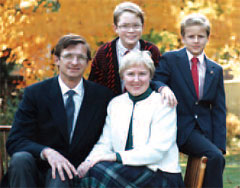
My son Andrew was born in 1978 and Eric in 1981. The family became too large for the house in Brighton so in 1983 we moved to Winchester, Massachusetts, where we slowly renovated a 1904 Arts and Crafts style house. A bindery on the third floor allowed Nancy to practice book conservation while our sons were growing up. Half the basement became my woodworking shop; the other half became at various stages a cub scout den, a teenage getaway, and later a finishing room for items built in my shop.
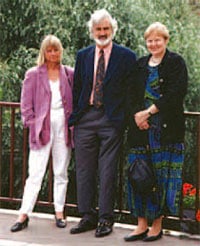
In 1997 Nancy accepted a position as the Chief Collections Conservator of the Harvard College Libraries in Widener Library at Harvard University; in the summer of 2006 she will return to the MIT Libraries as the Thomas F. Peterson, Jr., Conservator of the Special Collections. With the children on their own we enlarged the kitchen/living area in 2000 and in the process expanded the basement, adding another room for woodworking and a small wine cellar. We enjoy cooking together in the new kitchen and gardening on our manageable 1/4 acre lot.
As of 2006 I have published approximately 425 papers and have trained ~65 graduate students and ~75 postdoctoral students. I still find the process of unlocking nature’s secrets an enormously satisfying profession and hope to be fortunate enough to continue to practice it for some time.
This autobiography/biography was written at the time of the award and first published in the book series Les Prix Nobel. It was later edited and republished in Nobel Lectures. To cite this document, always state the source as shown above.
Nobel Prizes and laureates
Six prizes were awarded for achievements that have conferred the greatest benefit to humankind. The 12 laureates' work and discoveries range from proteins' structures and machine learning to fighting for a world free of nuclear weapons.
See them all presented here.
